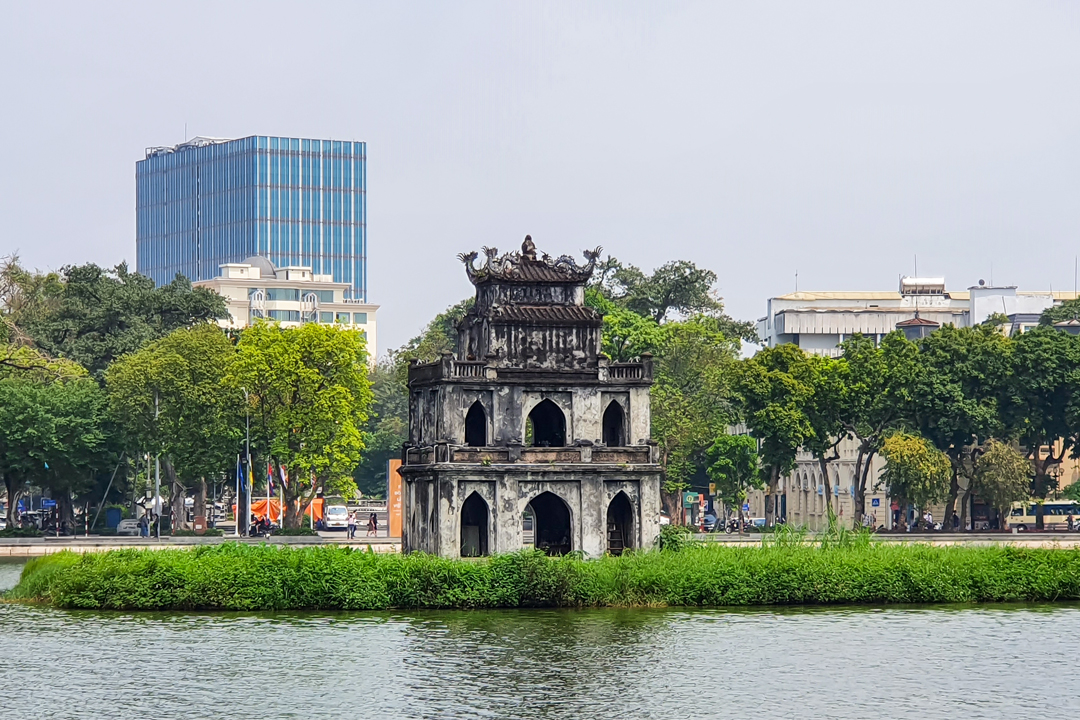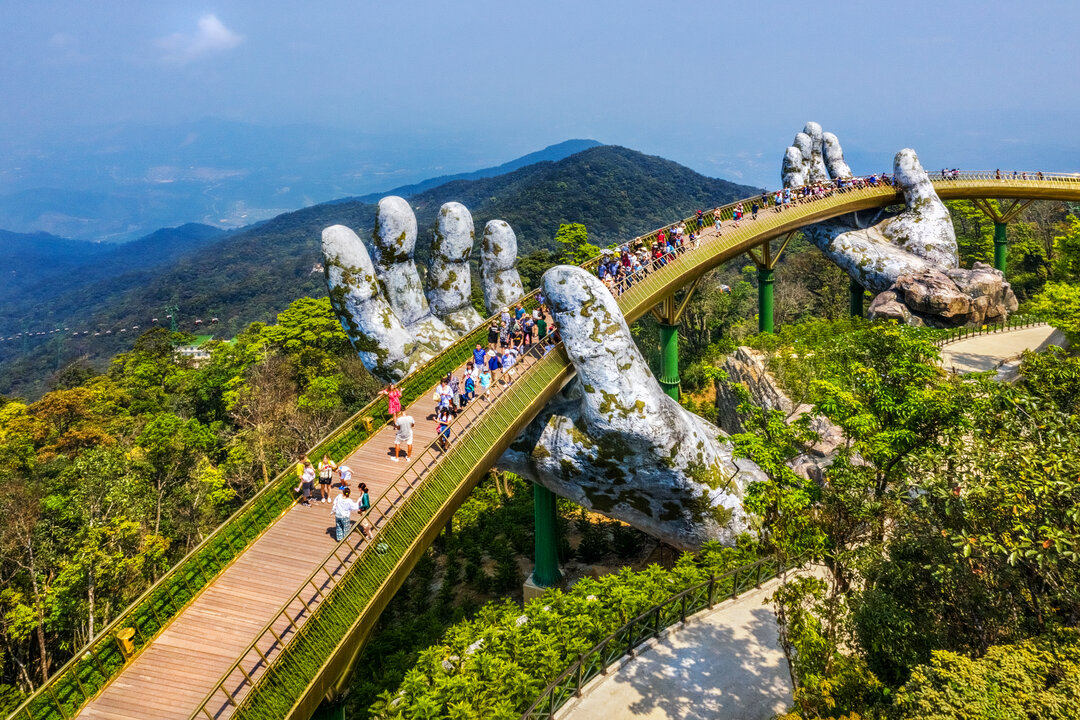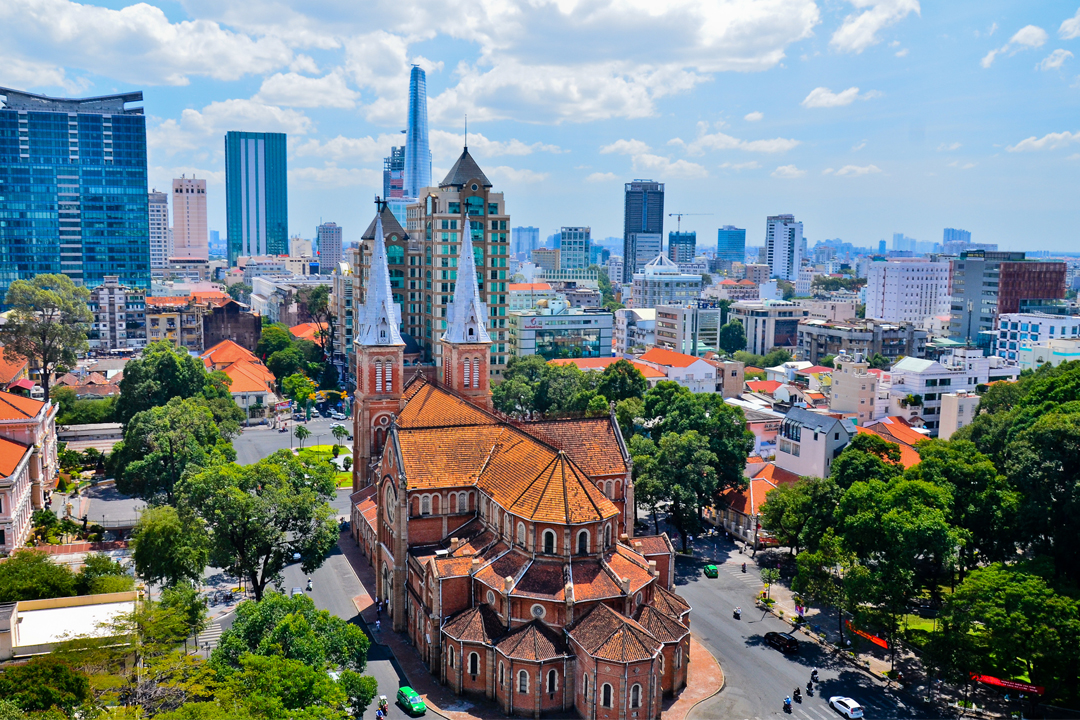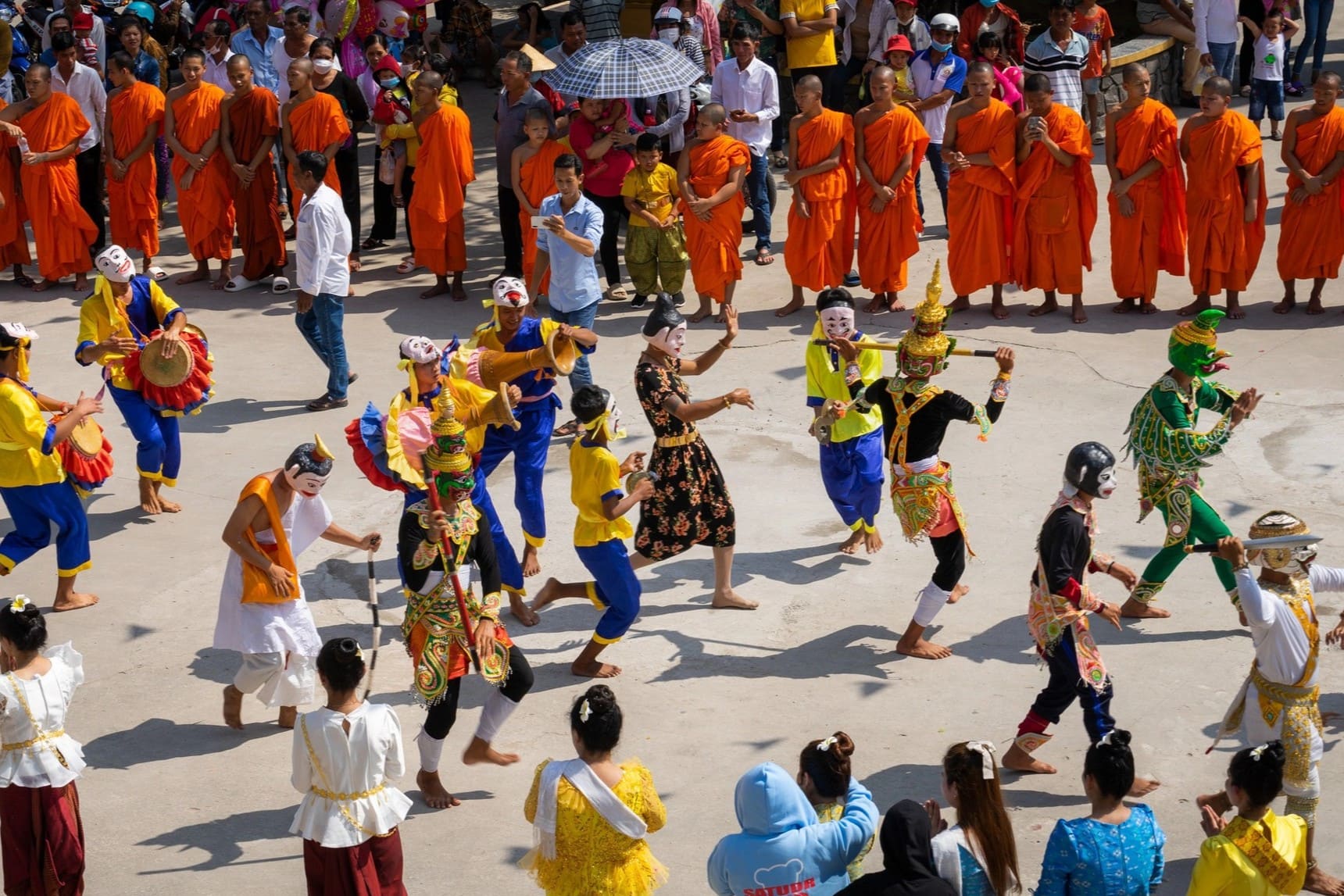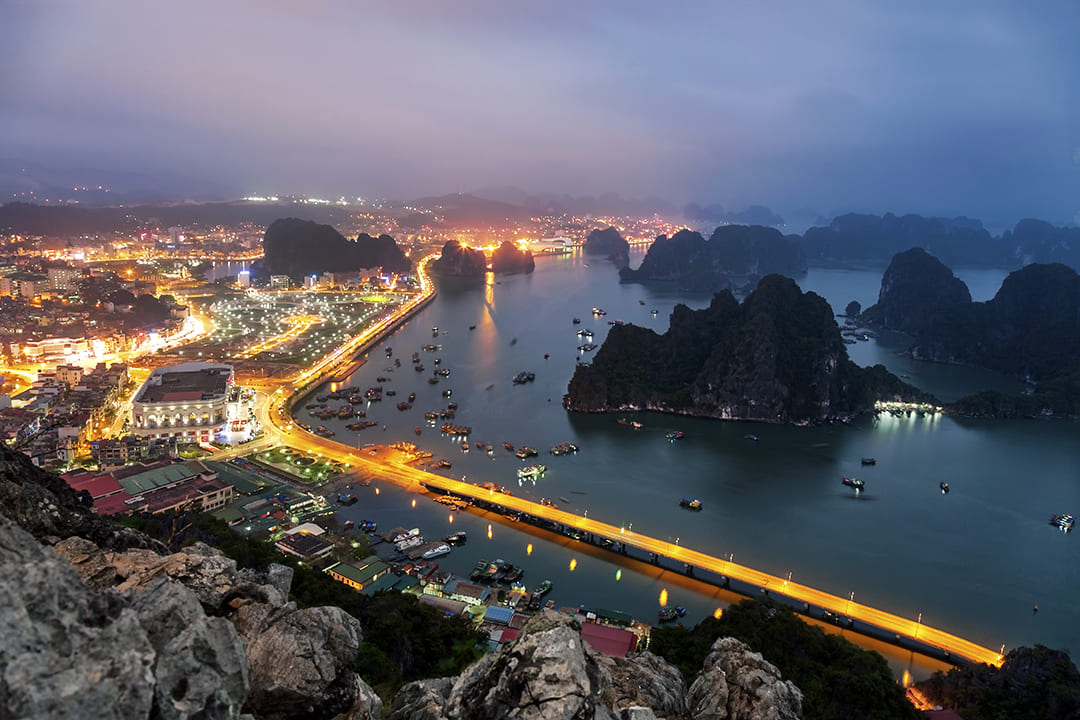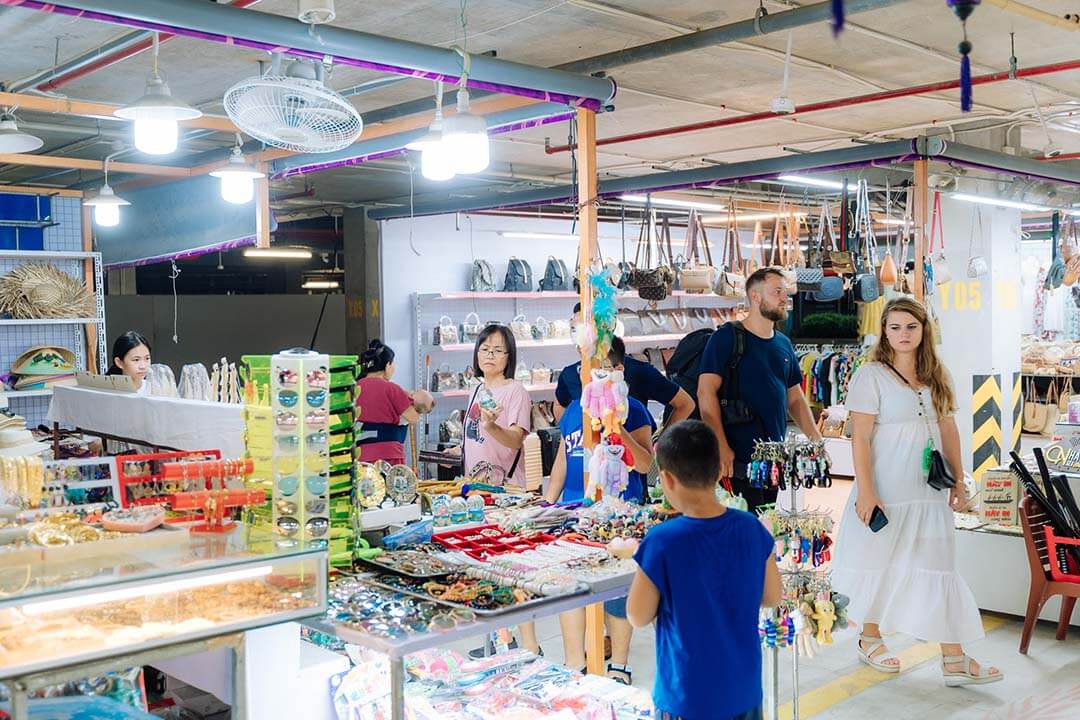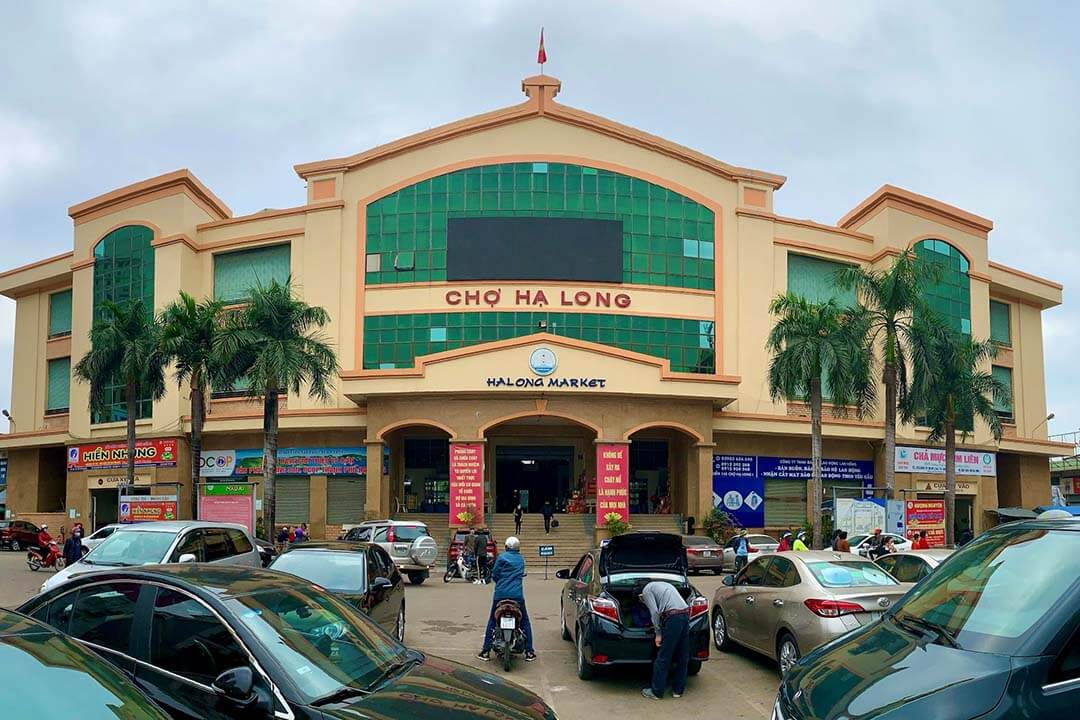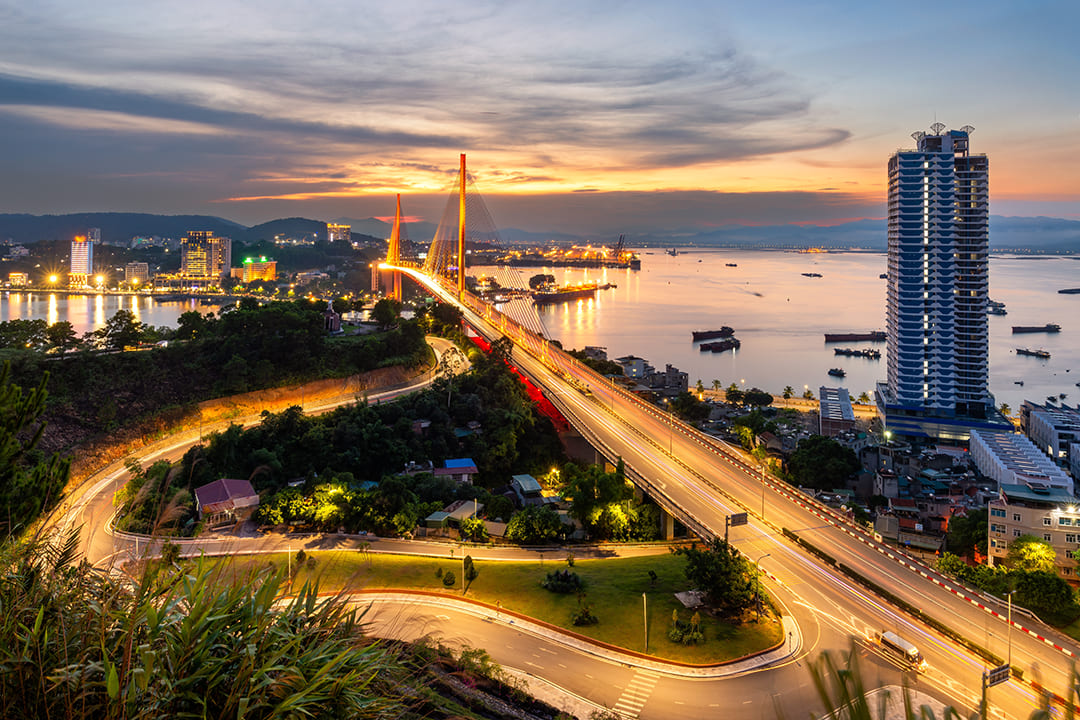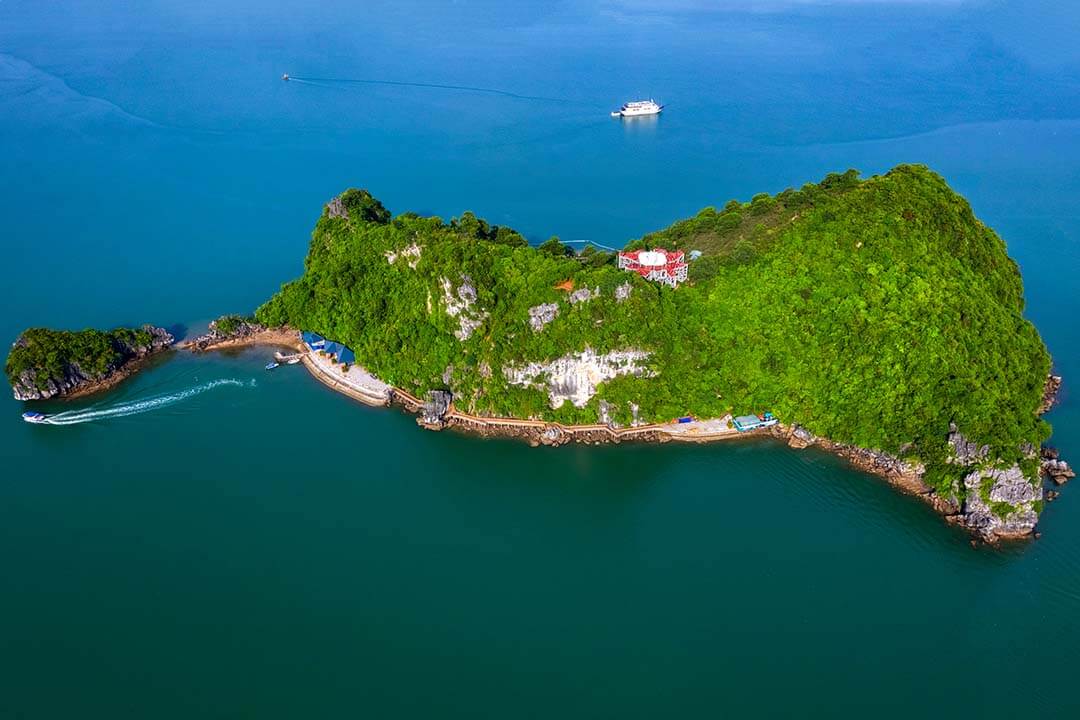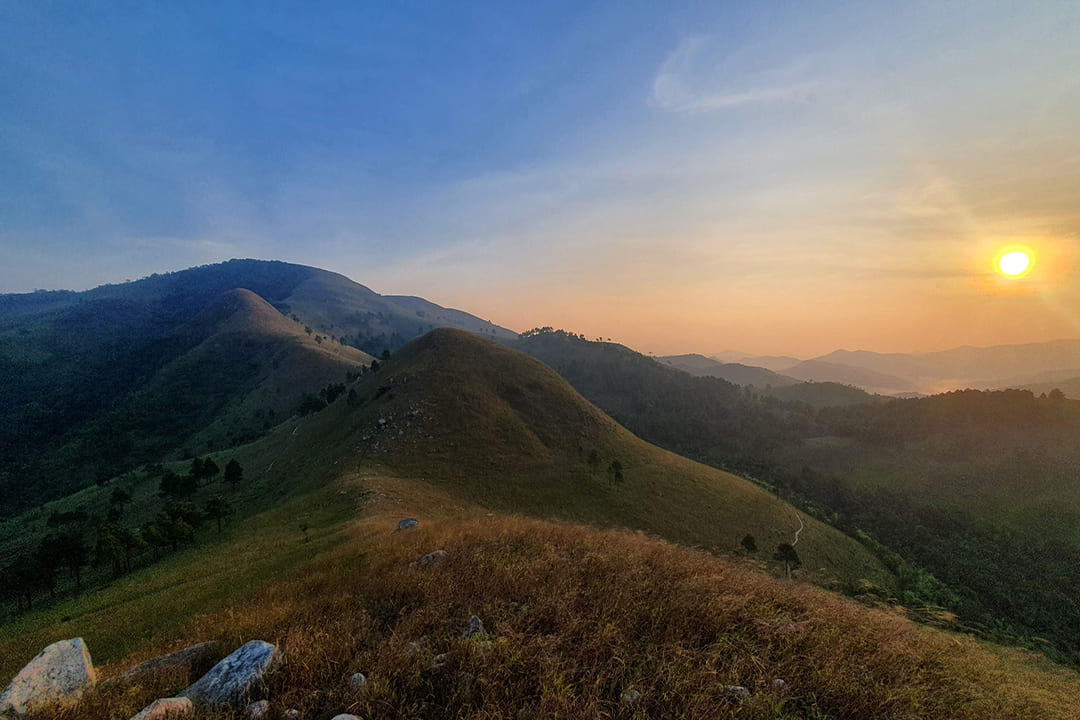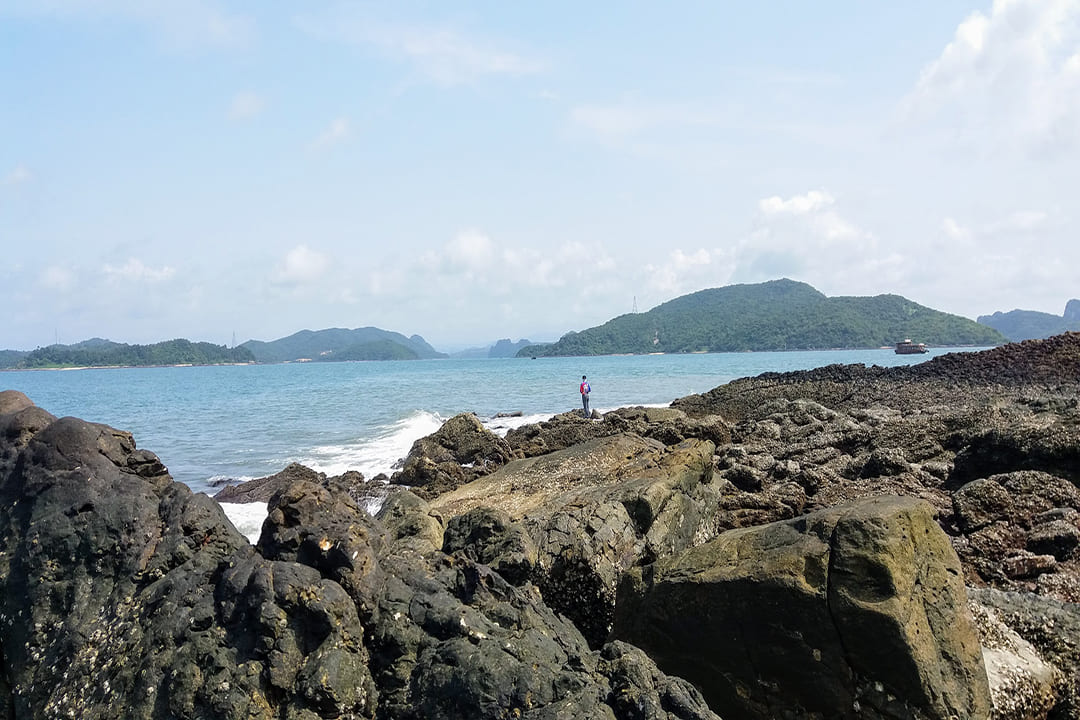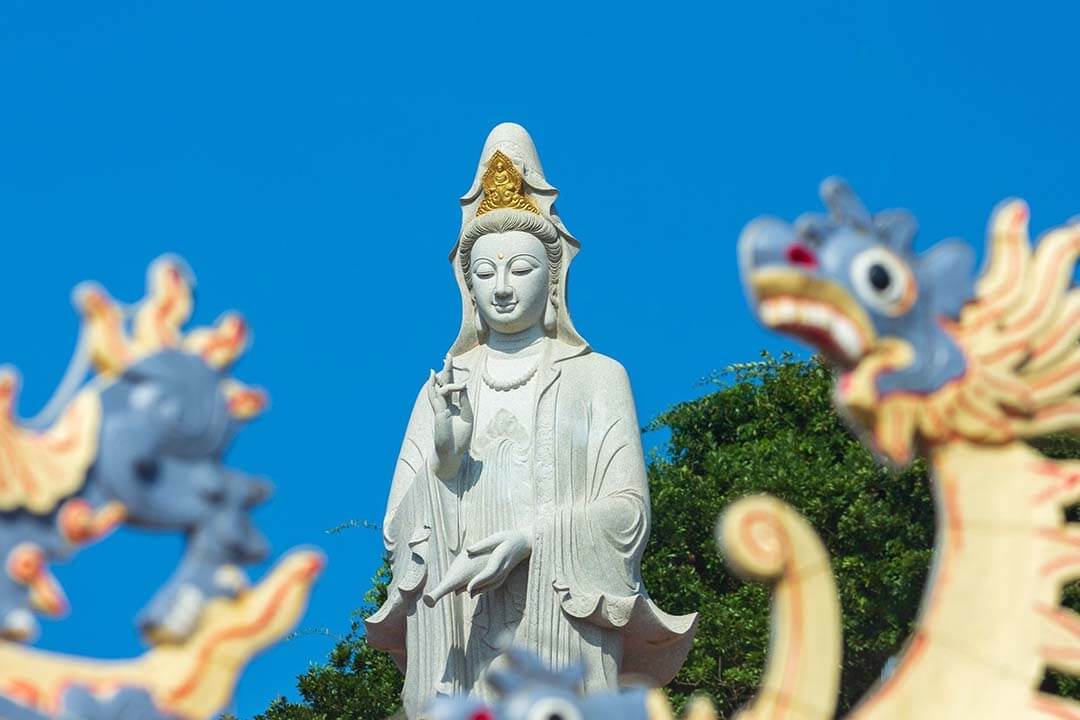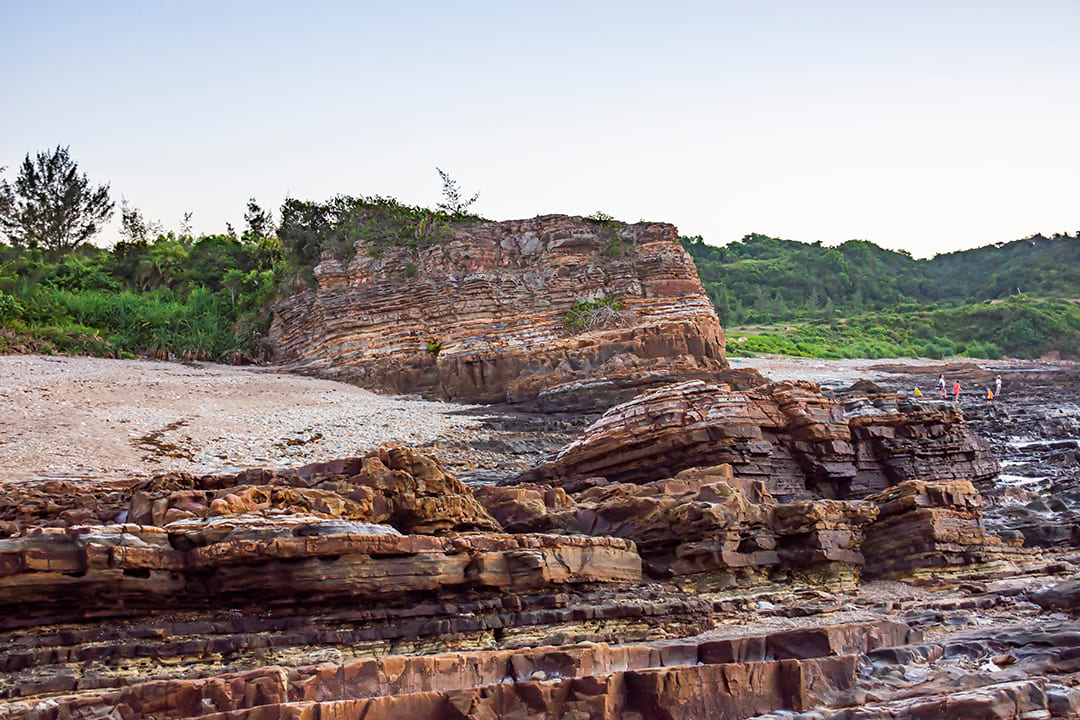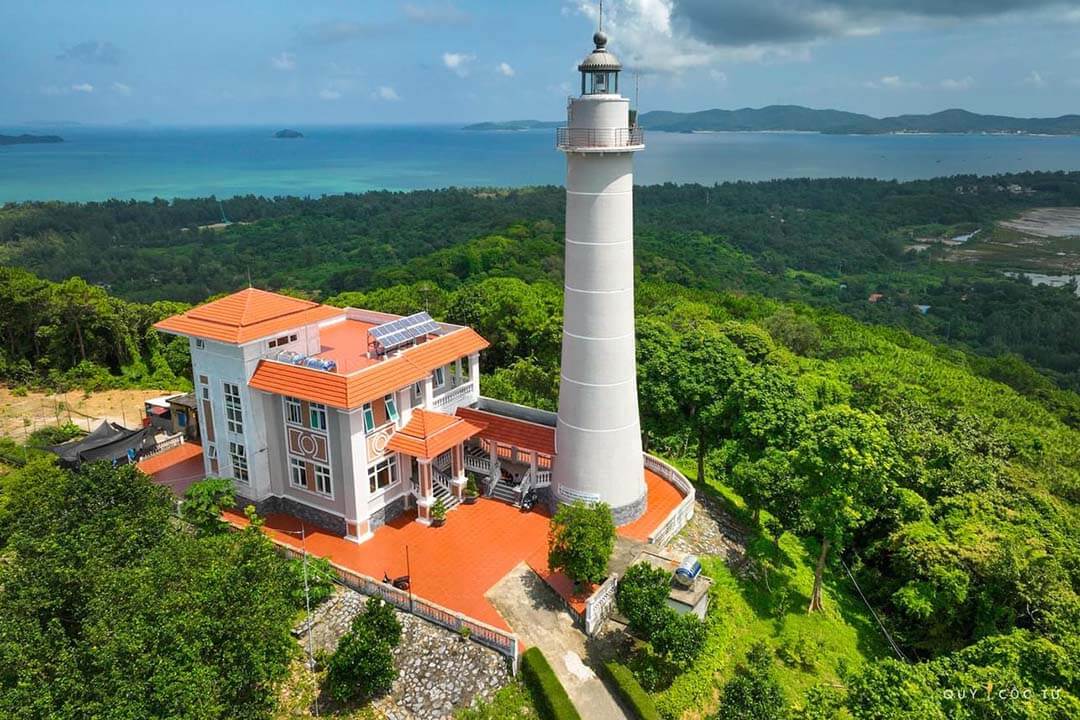Feb - 20 - 2025
Yen Tu Mountain, located in Quang Ninh Province, Northern Vietnam, is a site of immense natural beauty and spiritual significance. Standing 1,068 meters above sea level and often cloaked in mist, this "White Cloud Mountain" creates an enchanting atmosphere, drawing visitors in search of peace and cultural depth.
This revered mountain holds a unique place in Vietnamese Buddhism, serving as both a historical and spiritual pilgrimage site. As a center for Zen Buddhism, Yen Tu Mountain provides visitors with meaningful experiences through visits to sacred temples, pagodas, and monasteries. The mountain also offers diverse activities, from scenic hikes through tropical and temperate forests to a cable car journey, each revealing the stunning landscape and rich biodiversity.
Yen Tu brings together natural allure, sacredness, and cultural heritage, inviting travelers to immerse themselves in both the region’s scenic beauty and profound spiritual legacy. Let's find out the answer with GTrip about what makes Yen Tu Mountain sacred and things to do below!
What makes Yen Tu Mountain a sacred heritage?
The mountain is revered as a sacred heritage due to its deep-rooted significance in Vietnamese Buddhism, history, and culture. This majestic mountain is recognized as the birthplace of Truc Lam Zen Buddhism, a unique Vietnamese school of Buddhism founded by King Tran Nhan Tong. In the late 13th century, the king abdicated and retreated to Yen Tu, choosing a monastic life dedicated to spiritual peace and detachment from worldly concerns. His teachings and life marked the beginning of a new spiritual path that has since shaped Vietnamese Buddhism.
The mountain is adorned with ancient temples, pagodas, and shrines that stand as a testament to centuries of devotion and artistic heritage. Structures like Hoa Yen Pagoda and Dong Pagoda hold particular historical and cultural importance, embodying architectural styles of Vietnam’s dynasties. These sacred spaces serve not only as places for Buddhist rituals but as symbols of cultural resilience and artistic achievement. Monks and followers frequently gather here to perform rituals, chanting prayers and meditating in honor of the spiritual teachings upheld in this sacred site. Each temple and pagoda, from the foothills to the peak, signifies a journey toward enlightenment and peace.
Surrounded by tranquil landscapes, including serene streams, lush valleys, and towering forests, the mountain offers a unique environment for spiritual reflection. The natural beauty here enhances the mountain’s spiritual aura, inviting pilgrims and travelers to connect with both nature and a timeless spiritual heritage. This harmonious blend of nature, history, and Buddhism has led to the mountain’s international recognition. Yen Tu Mountain is a revered pilgrimage site, embodying Vietnam’s rich spiritual heritage and inspiring peace and enlightenment in its visitors.
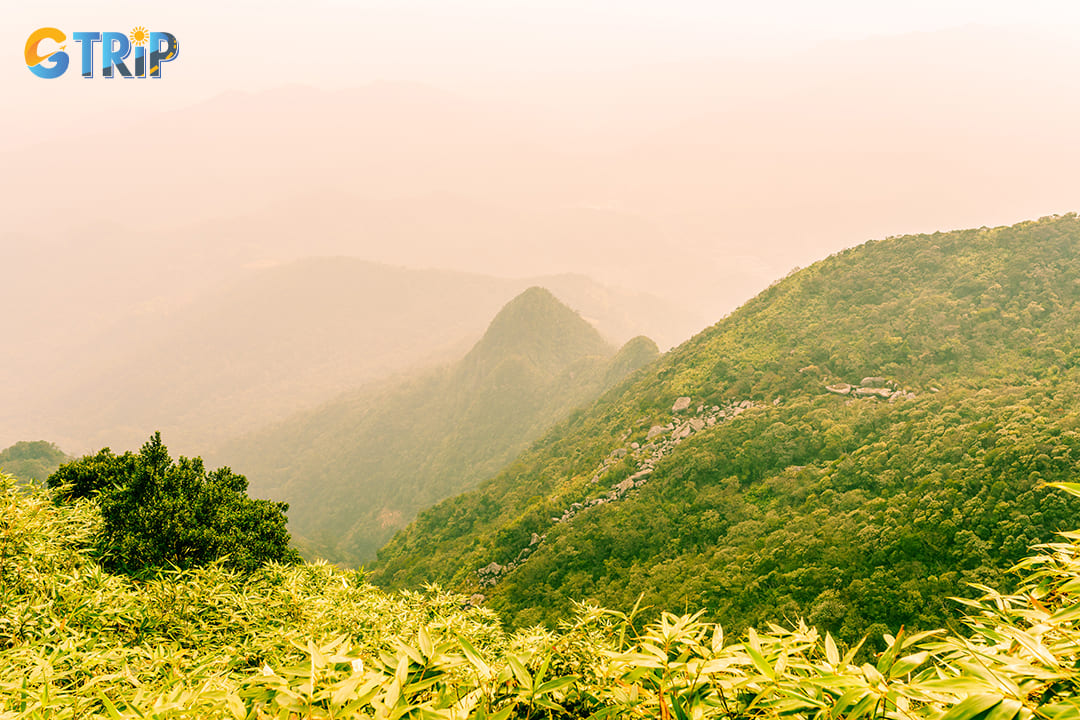
Beautiful landscape with fog and clouds on the mountain
10 things to do in Yen Tu Mountain
This mountain offers a rich array of activities, from spiritual pilgrimages and temple visits to scenic hikes, cultural exploration, and breathtaking views.
Hiking at Yen Tu Mountain
Hiking there is a journey filled with natural beauty, historical landmarks, and spiritual depth. The hike begins at the mountain’s foot, where the trail leads through lush greenery, bamboo groves, and rocky paths lined with thousands of ancient stone steps. As hikers ascend, they pass several key landmarks, each adding unique cultural significance to the trek. It can take anywhere from 4 to 6 hours, depending on the pace and exploration stops of the tourist.
After beginning the climb, one of the first major stops is Hoa Yen Pagoda, nestled amidst clouds and surrounded by ancient pine trees. Here, travelers can explore historical relics and join in quiet reflection alongside monks and pilgrims who have come to pay respects. Continuing the hike, you’ll encounter the Mot Mai Pagoda, which clings to the cliffside and offers stunning views of the mountain landscape below. Each pagoda and shrine along the route provides a space to observe traditional Buddhist practices, adding a spiritual dimension to the journey.
The final stretch leading up to Dong Pagoda at the summit is both the most challenging and the most rewarding. This pagoda, built from bronze, is perched at the mountain’s peak and is often shrouded in mist, giving it an ethereal atmosphere. The summit offers breathtaking views of the surrounding mountains and forests, making the rigorous ascent worthwhile. Hiking on this mountain is both an adventurous journey through rugged terrain and a path toward cultural and spiritual connection. This makes it one of Vietnam's most unique hiking experiences.
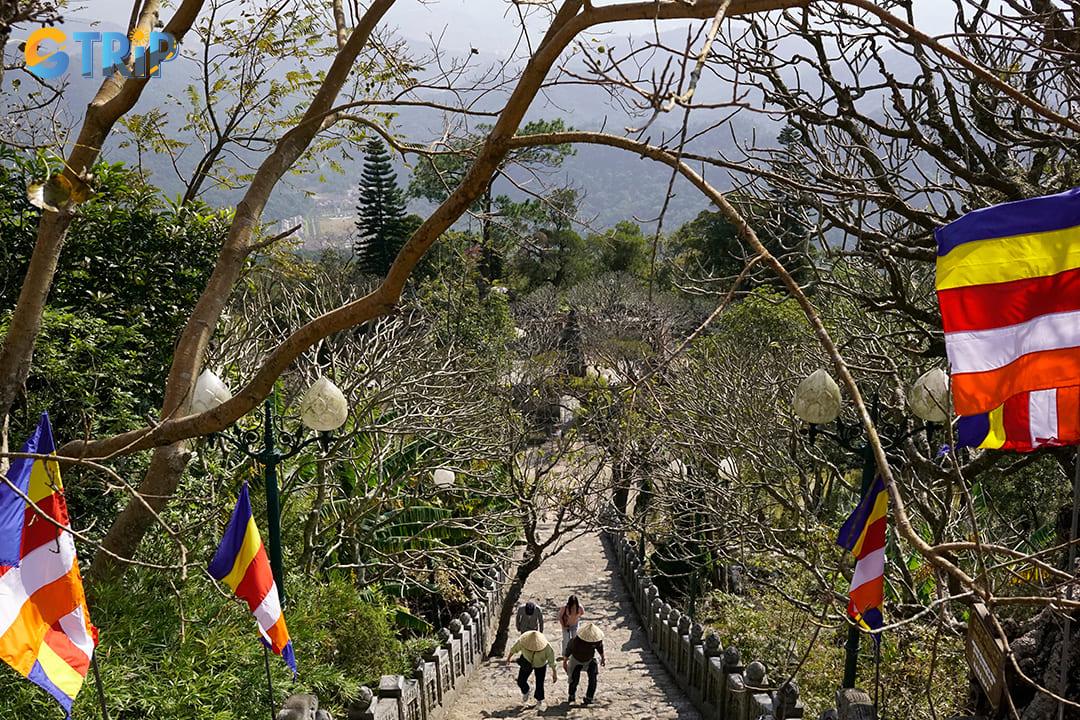
Tourists hiking up to the mountain by stairs
Experience Yen Tu Mountain's panoramic view by cable car
Taking the cable car at this mountain offers a breathtaking way to experience the mountain’s panoramic views without the rigorous hike. As the cable car glides above dense forests, rocky slopes, and mist-laden valleys, passengers are treated to stunning vistas of the serene landscape below. This convenient option brings travelers close to key sites like Hoa Yen Pagoda, providing easy access to Yen Tu’s rich spiritual and cultural heritage.
Ideal for families, seniors, or those short on time, the cable car transforms the journey into a scenic, effortless ride, reducing the time to the summit to just minutes. The eco-friendly system, designed for minimal environmental impact, is safe and comfortable, allowing passengers to fully admire the mountain’s natural splendor. Ticket options vary depending on the route, offering flexible choices to explore this stunning site.
The ticket prices for cable car:
- Gia Hanh Temple to Hoa Yen Temple: One-way ticket: 200,000 VND/person. Round-trip ticket: 280,000 VND/person.
- Mot Mai Temple to An Ky Sinh Temple: One-way ticket: 200,000 VND/person. Round-trip ticket: 280,000 VND/person.
- Downhill on both lines: 280,000 VND/person.
- Round trip on both lines: 350,000 VND/person.
- For those who hike halfway and then purchase a ticket to continue by cable car (up one line and down two lines), the price is 350,000 VND/person.
- Exemptions: Seniors over 70 (with ID or senior citizen card), war invalids (with war invalid card), children under 1.2 meters, and monks and nuns are exempt from ticket fees.
The Yen Tu cable car system includes two main routes. These routes make it easy for you to explore key spiritual sites and enjoy stunning views of the landscape.
- Hoang Long Line: This 1.2 km route, featuring 35 cabins, begins at the mountain's base and ascends to the Hue Quang Ancestor Tower.
- Bach Long Line: Stretching 900 meters with 38 cabins, this line transports passengers from the eastern side of Mot Mai Temple to the An Ky Sinh statue area, bringing them closer to Yen Tu’s peak.
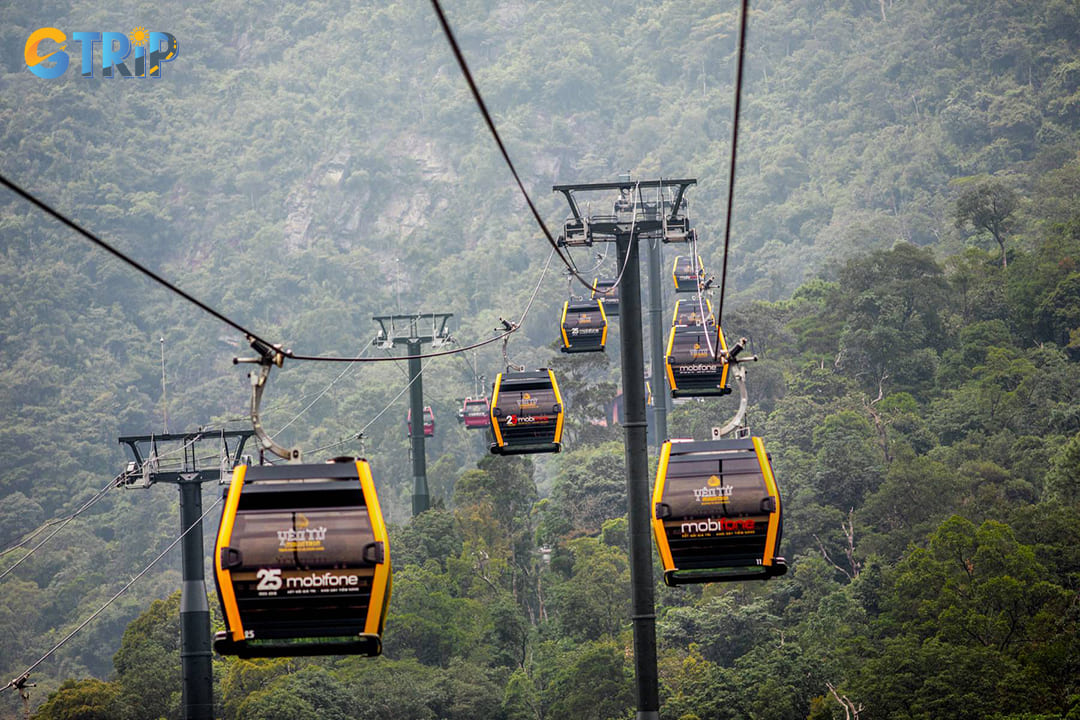
The Yen Tu cable car system supports travelers with the best view of the mountain
Visit Truc Lam Yen Tu Zen Monastery
Truc Lam Yen Tu Zen Monastery is also known as Lan Pagoda or Long Dong Pagoda. A visit to Truc Lam Yen Tu Zen Monastery provides a deeply immersive experience into Vietnamese Zen Buddhism. The monastery invites guests to explore its serene gardens, where traditional Vietnamese architecture and tranquil landscapes evoke peace. Within the main hall, you can admire statues of Buddha and King Tran Nhan Tong, honoring the spiritual legacy of the king who founded Truc Lam Zen.
Guided teachings by resident monks offer insights into mindfulness and meditation, encouraging a connection with the Zen practices developed here centuries ago. Guests can participate in meditation sessions, enhancing their understanding of Vietnamese Zen philosophy. The monastery’s on-site vegetarian restaurant allows for a complete experience, offering meals prepared with Buddhist principles of purity, simplicity, and nourishment.
You can also attend rituals and explore the surrounding temple grounds, absorbing the atmosphere of tranquility that defines the monastery. A visit to Truc Lam Yen Tu Zen Monastery brings a unique opportunity to engage with the teachings, serenity, and spiritual beauty.
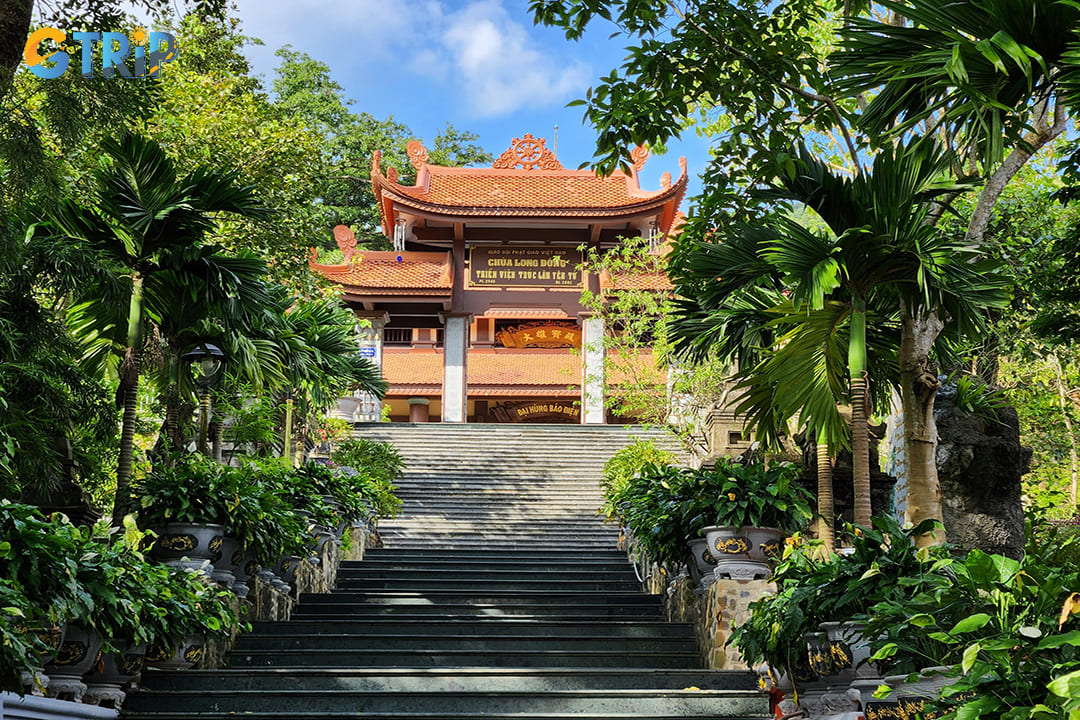
The gate of Long Dong Pagoda on the mountain
Explore Giai Oan Pagoda
Exploring Giai Oan Pagoda reveals the serene beauty and powerful legends that define its spiritual significance. Nestled at the base of the mountain, the pagoda stands by the tranquil Giai Oan Stream. This stream is steeped in legend, marking the place where royal concubines ended their lives after following King Tran Nhan Tong into monastic life. They took this tragic step upon failing to convince him to return to his throne. In their honor, the king built Giai Oan Pagoda as a requiem, making it a place of deep reverence and remembrance.
The pagoda, rebuilt in 1994 after centuries of weathering and wartime damage, showcases unique architecture honoring Buddhist deities and figures from the Truc Lam Zen tradition. It is also the only site on Yen Tu Mountain dedicated to King Tran Nhan Tong’s mother, adding to its historical and spiritual significance. The pagoda grounds also feature six tower graves, holding the ashes of revered monks who lived and led spiritual lives there.
Tourists to Giai Oan Pagoda can explore its tranquil surroundings, observe rituals, and join in prayers. This sacred site invites travelers to discover its history, offering a unique experience of devotion and spirituality that reflects the intertwining of legend and heritage at the mountain.
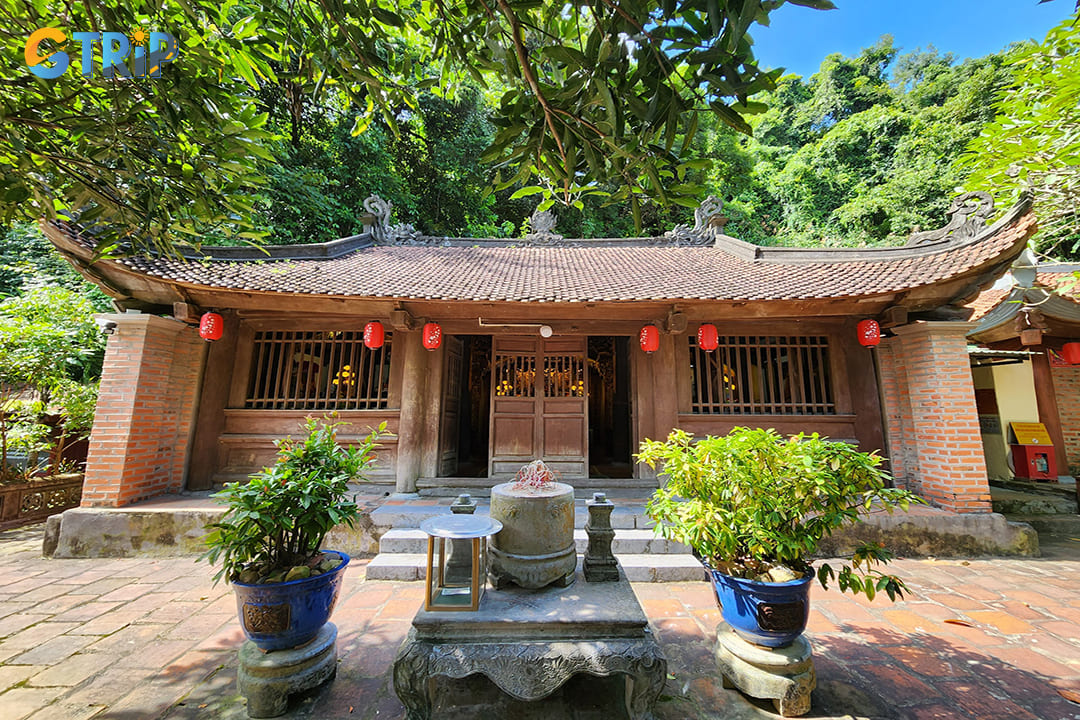
Giai Oan Pagoda stands by the tranquil Giai Oan Stream
Check-in with Yen Tu Valley of Flowers
The Yen Tu Valley of Flowers, situated at the foot of Yen Tu Mountain, offers visitors a captivating natural escape filled with vibrant flower gardens and diverse plant life. Designed to reflect the harmony between nature and spirituality, the valley is home to a wide variety of seasonal blooms, from radiant cherry blossoms to delicate orchids. This lush, picturesque landscape stretches across tranquil paths, inviting guests to explore and take in the beauty of the blossoming flowers against the dramatic mountain backdrop.
This valley is a popular spot for photography, with every corner offering a new burst of color and floral arrangement that captures the essence of Yen Tu’s natural beauty. You can wander along winding trails lined with floral displays, breathe in the fresh, fragrant air, and immerse themselves in the peaceful atmosphere. As a place where flora and landscape design converge, the Yen Tu Valley of Flowers is an ideal destination for those seeking both visual beauty and a serene escape into nature.
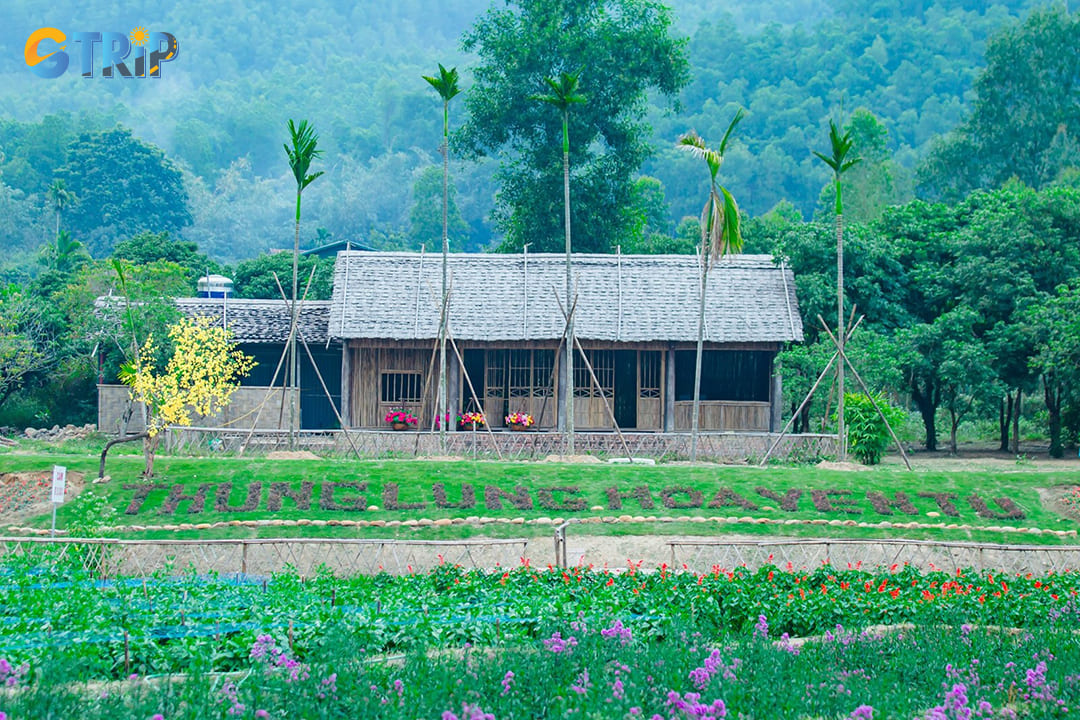
Beautiful and colorful flowers make it ideal for perfect photos
Find tranquility with Dong Pagoda
Dong Pagoda, perched on the peak of Yen Tu Mountain at an elevation of 1,068 meters, offers a profound sense of serenity and spiritual connection. The pagoda, constructed entirely from copper, is a magnificent symbol of Vietnamese Buddhist architecture. Weighing 70 tons and built in a unique style, Dong Pagoda stands as the largest copper pagoda in Asia. It is a significant pilgrimage site for Buddhists, honoring King Tran Nhan Tong and the Truc Lam Zen ancestors.
Upon reaching the summit, people are greeted by panoramic views of the surrounding landscape, an awe-inspiring sight that adds to the pagoda’s spiritual allure. From this vantage point, the vastness of Yen Tu and Dong Trieu Mountains stretches before you, offering a perfect setting for meditation and contemplation. The fresh, cool mountain air, combined with the stillness of the pagoda’s environment, creates an atmosphere of inner peace and tranquility. This is a place where one can disconnect from the noise of everyday life and reconnect with nature and spirituality.
People often pause at the pagoda to engage in prayer and quiet reflection. The beauty of Dong Pagoda lies not only in its remarkable structure but also in the calmness it evokes. As the final destination on your journey through Yen Tu Mountain, it serves as the ultimate sanctuary. It offers an opportunity for spiritual renewal and a deeper connection to Vietnamese Buddhist traditions.
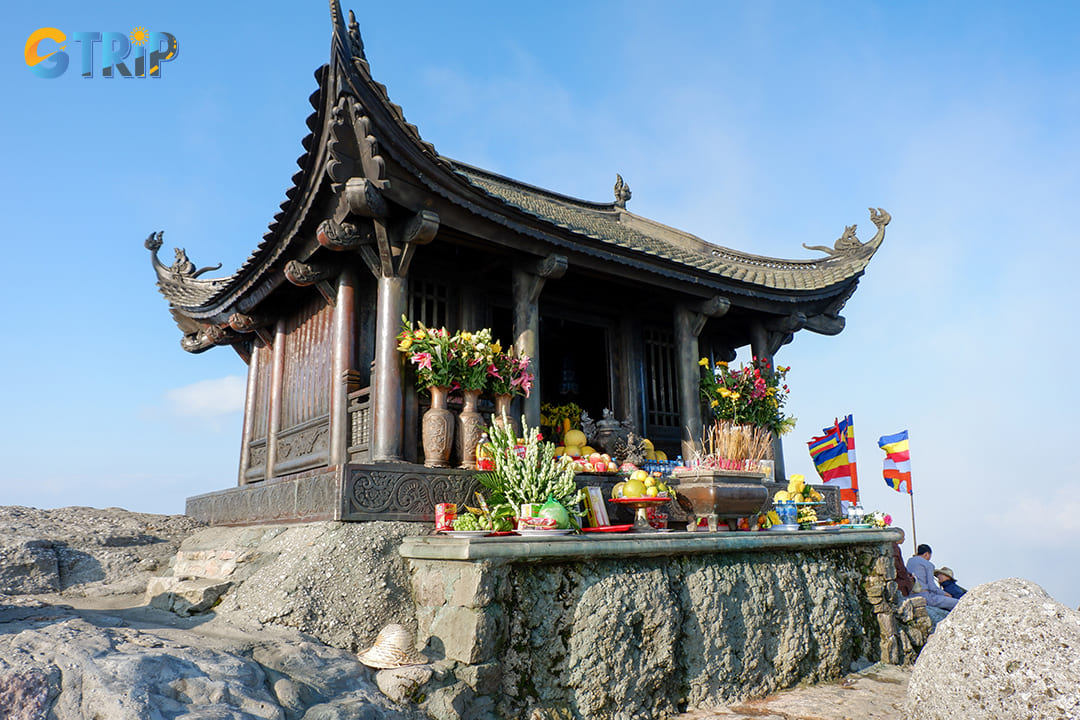
The Dong Pagoda lies on the peak of the mountain
Admire Heaven's Gate on Yen Tu Mountain
Admiring Heaven’s Gate on the mountain offers a truly mystical experience, with breathtaking views and a touch of spiritual legend. This iconic landmark surrounds An Ky Sinh Rock, a two-meter-tall outcrop that rises boldly near the mountain’s summit. Named after the ancient Taoist An Ky Sinh, this revered rock symbolizes both spiritual transcendence and natural beauty. Legend has it that An Ky Sinh achieved enlightenment on this mountain and turned to stone here, making the rock a sacred site. Many people stop to rub coins on the rock, a gesture believed to bring prosperity.
As you approach Heaven’s Gate, mist often shrouds the area, giving it an ethereal quality and adding to its name's fitting allure. Here, you can behold sweeping, serene vistas that seem to stretch endlessly across the mountain landscape. The misty rock formations at Heaven’s Gate create an ethereal atmosphere, making it a must-visit for those drawn to Yen Tu's natural beauty and spiritual ambiance.
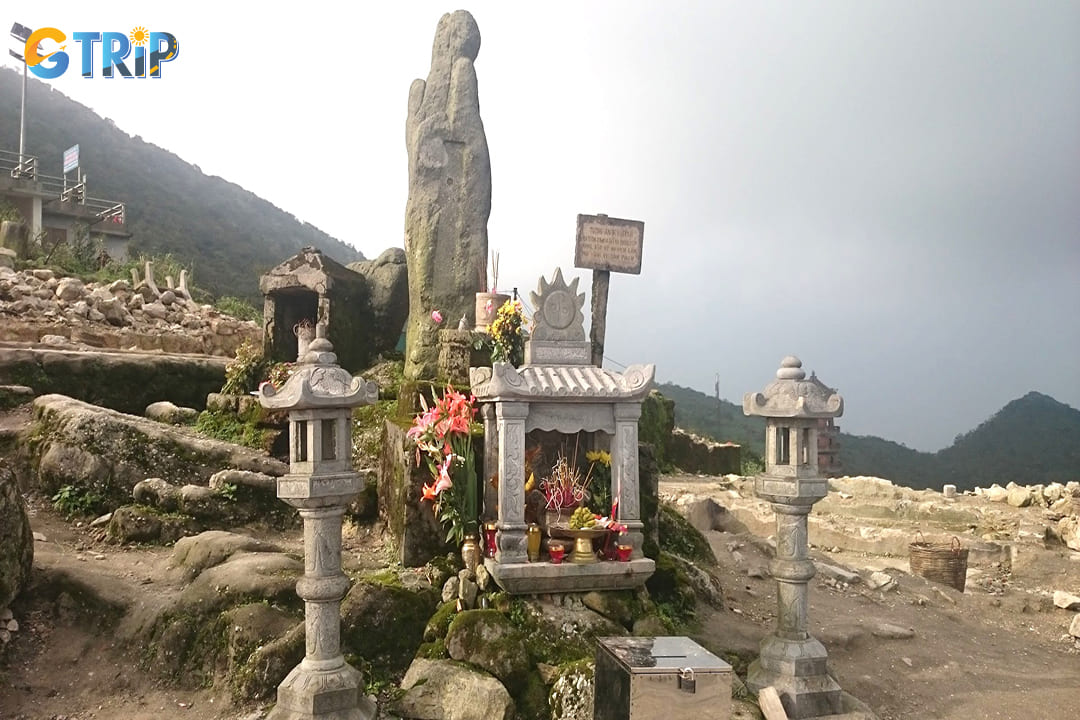
Reaching An Ky Sinh Rock, travelers almost reach the top of the mountain
Visit Hoa Yen Pagoda
At Hoa Yen Pagoda, you can immerse themselves in a blend of spiritual and historical experiences while appreciating the pagoda's ancient architecture and serene setting. Meditation and prayer are popular here, with visitors often sitting in peaceful contemplation or joining in prayer to honor the Buddhist gods and ancestors worshiped in this sacred space. The main hall, beautifully preserved and surrounded by tranquil gardens, invites worship and reflection on the lives of significant Zen figures such as King Tran Nhan Tong.
Tourists to Hoa Yen Pagoda will appreciate its classic Vietnamese design elements and intricate carvings that reflect the Zen Buddhist heritage of the mountain. The pagoda’s tranquil gardens, filled with ancient trees, add to its calm atmosphere, enhancing each visitor's experience. As the largest and most historically significant pagoda on Yen Tu Mountain, Hoa Yen Pagoda provides a profound setting for worship and reflection on the mountain’s spiritual legacy.
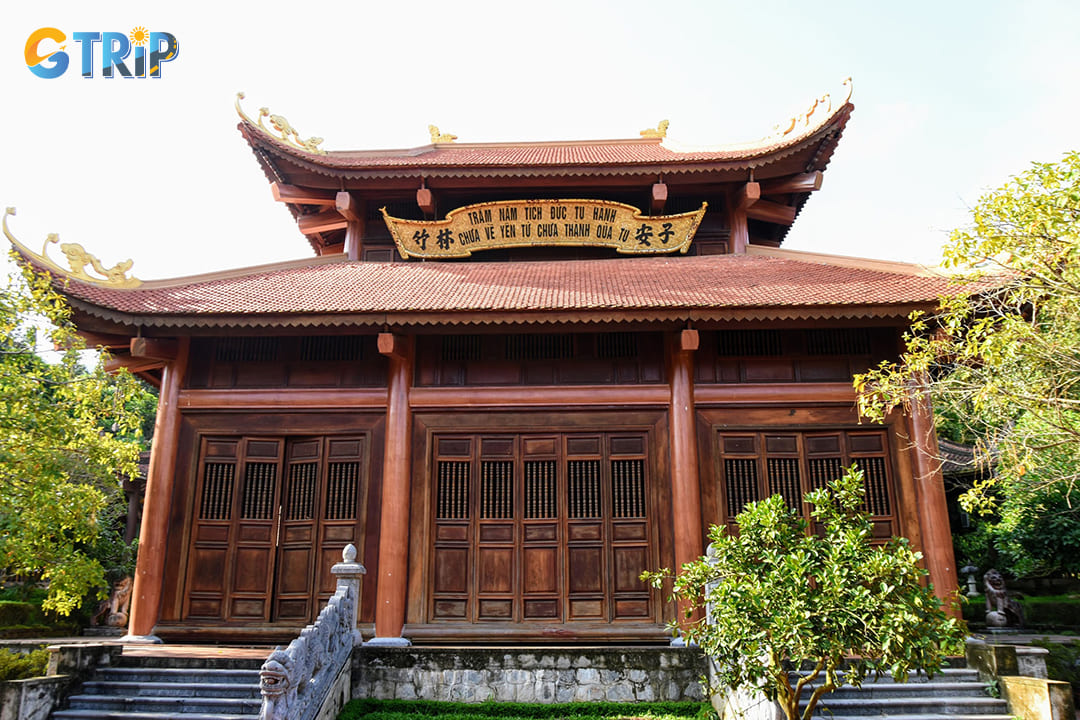
Hoa Yen Pagoda is the largest pagoda on the mountain
Admire the beauty of the Statue of Buddha King Tran Nhan Tong
The statue of Buddha King Tran Nhan Tong on Yen Tu Mountain is a breathtaking tribute to one of Vietnam's most revered Buddhist figures. Located at approximately 900 meters above sea level, the bronze statue is a grand 12.6 meters tall and weighs 138 tons, symbolizing spiritual strength and wisdom. Created through the work of nearly 5,000 artisans and completed in 2013, it replicates a smaller version of the Enlightened King’s statue housed in the Hue Quang Stupa.
The statue depicts King Tran Nhan Tong in serene meditation atop a lotus, facing southward, symbolically watching over the mountain and its stunning landscape. The statue's intricate design, with its base adorned in traditional Tran Dynasty motifs, reflects the masterful copper-casting techniques of Vietnam. This awe-inspiring monument is not only a marvel of art but also a sacred site. It invites visitors to pause, reflect, and honor a legacy of enlightenment and spiritual devotion that has endured for centuries.
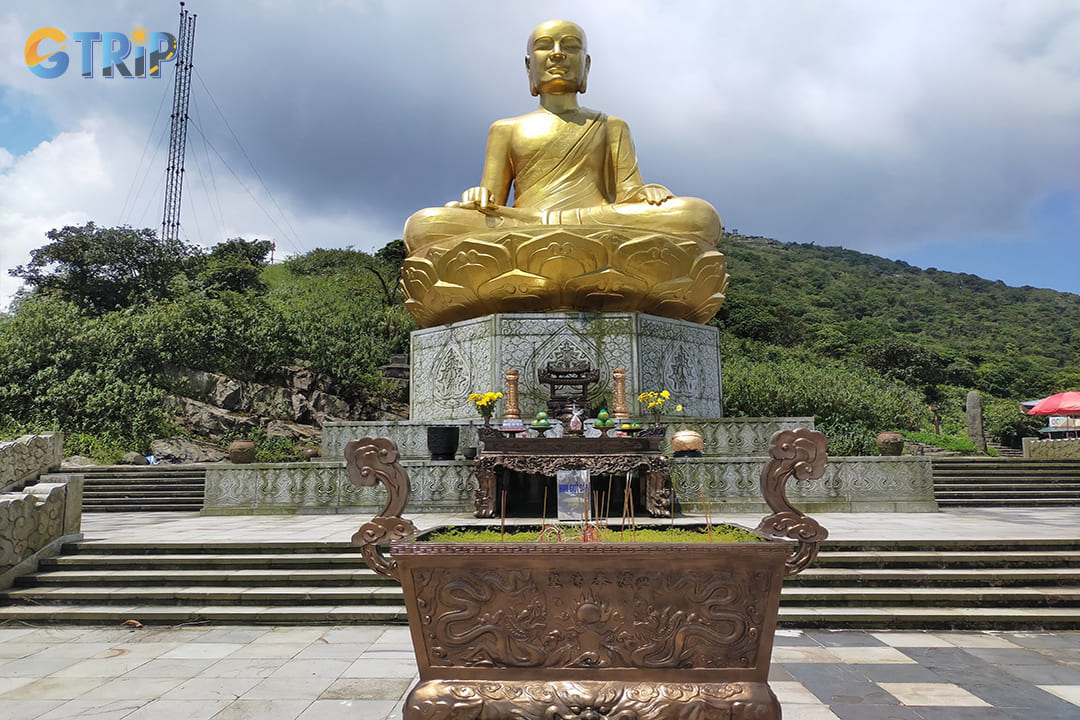
The statue of Buddha King Tran Nhan Tong on Yen Tu Mountain
Attend the Yen Tu Buddhist pilgrimage
Attending the Yen Tu Buddhist Pilgrimage offers a unique, transformative spiritual experience rooted in ancient Vietnamese traditions. The Yen Tu Buddhist pilgrimage begins on the 10th day of the first lunar month and extends through the third lunar month. This spiritual journey honors King Tran Nhan Tong, who renounced his throne to follow a life of Buddhism and established the Truc Lam Zen sect on Yen Tu Mountain. This annual event sees thousands of participants, monks, Buddhists, and those seeking spiritual enrichment, embark on a journey up the sacred mountain, united in faith and devotion.
The pilgrimage involves engaging in a series of ceremonies and rituals at Yen Tu's key pagodas, including Hoa Yen and Dong Pagoda. Participants stop along the trails to observe and join chanting sessions, make offerings, meditate, and listen to monks’ teachings, deepening their understanding of Truc Lam Zen. Each stage of the ascent invites reflection and reverence, while the views of Yen Tu’s misty, mountainous landscape offer a meditative backdrop. At the summit, pilgrims arrive at Dong Pagoda, a spiritual high point where they offer prayers. This moment brings a profound sense of peace, fostering a deep connection to both nature and the enduring Buddhist traditions that make Yen Tu a revered pilgrimage site.
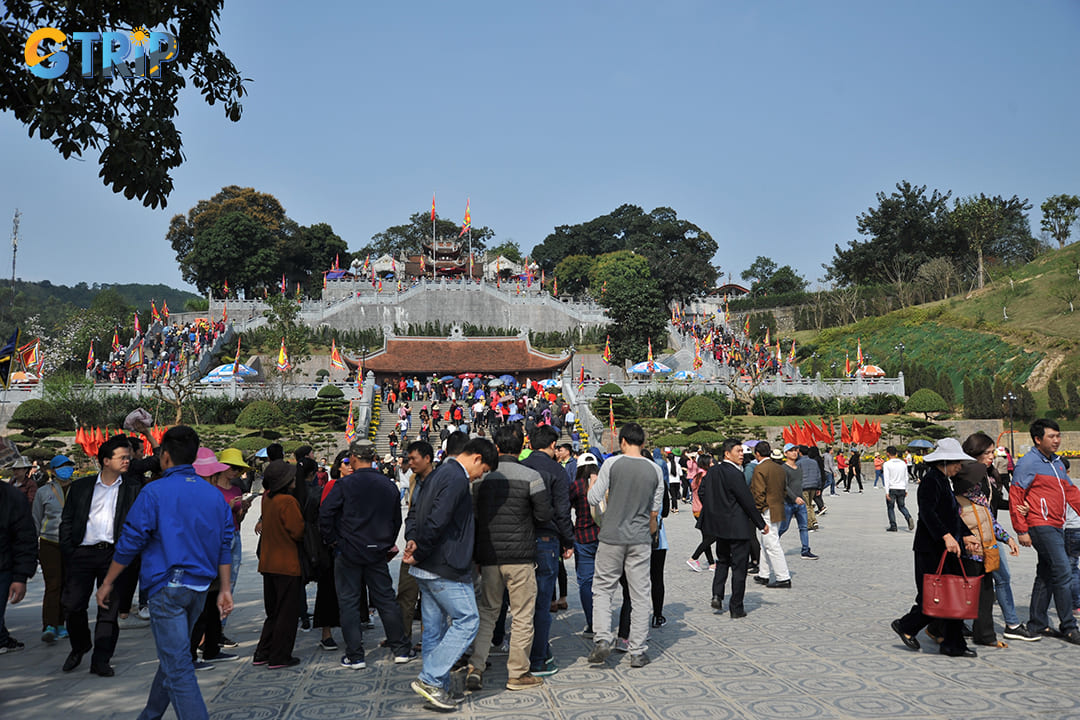
Thousands of pilgrims go to pagodas on the mountain
How to get to Yen Tu Mountain?
Reaching Yen Tu is an accessible journey with a variety of transportation options to suit different travel preferences. Located in Quang Ninh Province, Yen Tu is approximately 142 kilometers from Hanoi, with travel times and routes varying by mode of transportation.
By car or motorcycle
Traveling by car or motorcycle is a popular choice, as it provides flexibility and a scenic route. From Hanoi, the drive takes about 2.5 to 3 hours. The most direct route follows National Highway 18, taking you through the picturesque countryside and foothills of the Yen Tu Range. This route allows you to make stops at local attractions or scenic spots along the way, providing an enriching experience of Northern Vietnam's landscapes. For a smoother ride, make sure your vehicle is prepared for the mountain roads near Yen Tu, as they can be steep and winding.
By bus
If you prefer public transport, buses from Hanoi to Yen Tu are readily available. Departing from major bus stations such as My Dinh or Gia Lam, these buses typically take around 3 - 4 hours. Most buses stop in Uong Bi, where you can transfer to local transportation for the last segment to the mountain’s base. The bus journey is comfortable and ideal for budget travelers, and some services even offer VIP seats for added comfort. It’s wise to check bus schedules in advance, especially if you plan to return to Hanoi on the same day.
By train
Another scenic and convenient way to travel is by train from Hanoi to Uong Bi, the nearest train station to Yen Tu. The train ride takes roughly 3.5 hours, offering comfortable seating and views of the countryside. Once in Uong Bi, you can complete the journey by taxi or local bus to Yen Tu Mountain. The train is an excellent option for those who enjoy a relaxed pace and a unique travel experience, and it’s also a good choice during peak tourist seasons when buses may be crowded.
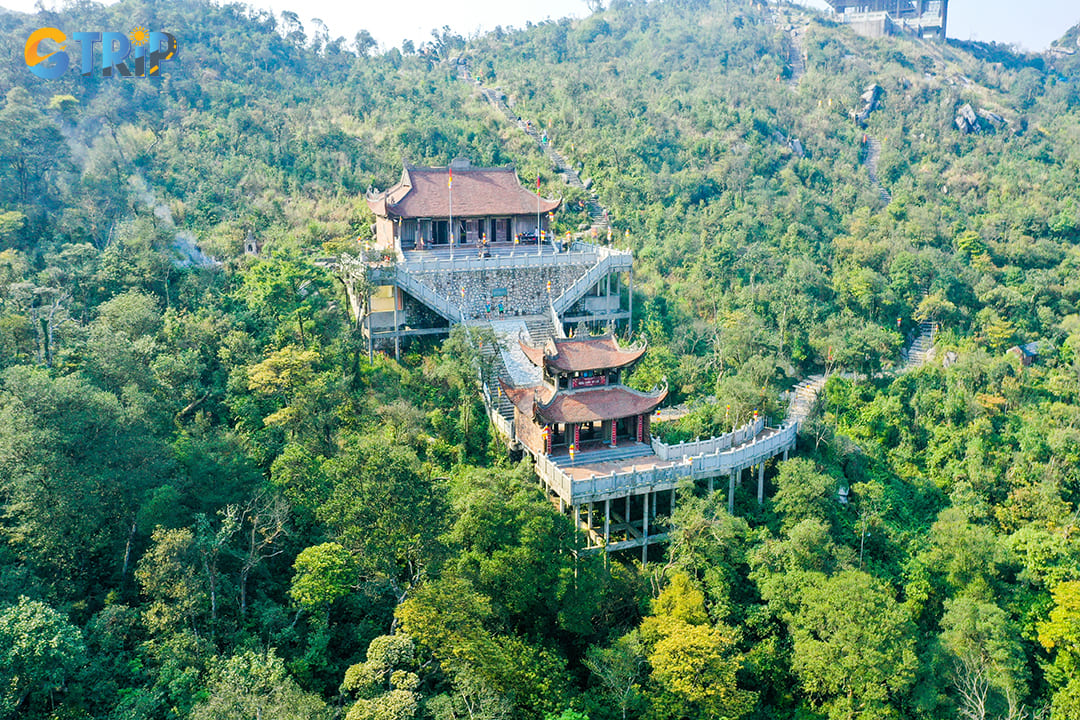
Get to Yen Tu to see this stunning and beautiful view of the mountain
When is the best time to visit Yen Tu Mountain?
The best time to visit Yen Tu is during the dry season, from October to April. Cool and dry conditions make it ideal for outdoor activities such as hiking and exploring the mountain’s many historical and spiritual sites. This season offers clear skies, comfortable temperatures, and easier trails, especially valuable for those tackling the steep ascent to the peak.
For those interested in cultural experiences, the Yen Tu Festival is a highlight, held from the 10th day of the first lunar month to the end of the third lunar month. This annual festival honors King Tran Nhan Tong, who founded Truc Lam Zen Buddhism, drawing thousands of pilgrims for ceremonies, prayers, and traditional performances. While this period brings a vibrant atmosphere and a deep sense of devotion, it’s also the peak season, so you should expect larger crowds. For a quieter experience with equally good weather, consider visiting just before or after the festival season.
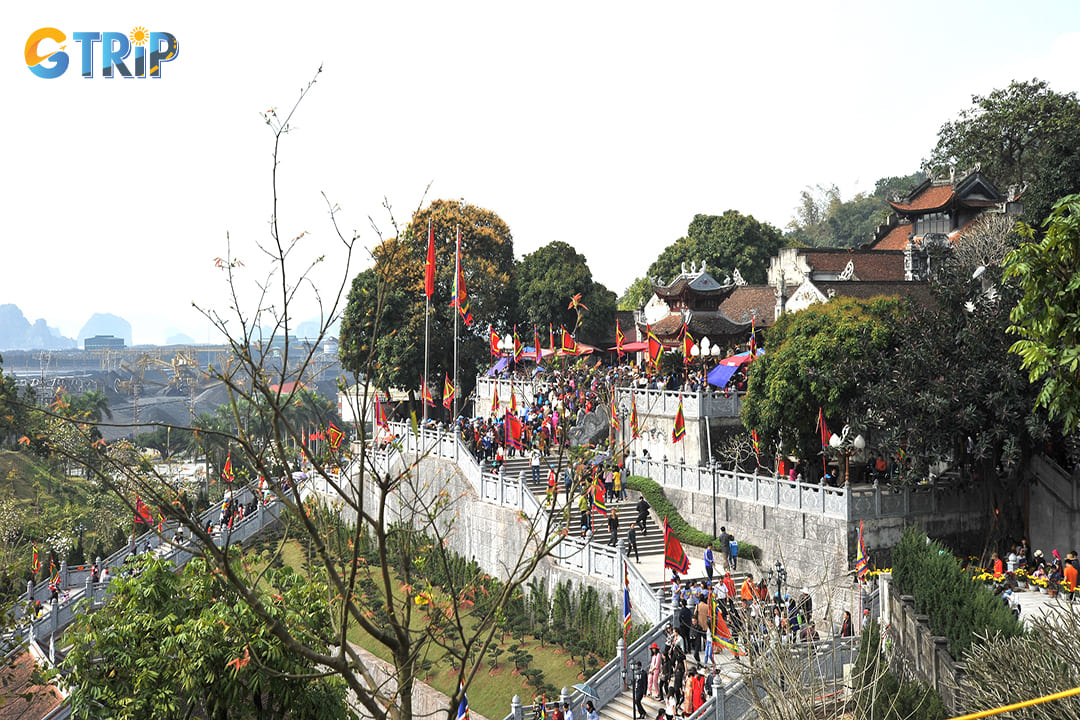
Yen Tu in festival season is a recommended time to experience culture
What to bring or wear when going to Yen Tu Mountain?
When visiting this mountain, it's essential to dress and pack appropriately for a comfortable and safe experience. You should choose lightweight, breathable clothing for warmer parts of the mountain, but also bring a sweater or jacket for cooler temperatures at higher altitudes. During the rainy season, you should bring a waterproof rain jacket or poncho to stay dry, and a hat and sunglasses can provide added sun protection. Sturdy hiking shoes or boots are recommended to navigate the mountain's rocky terrain.
In terms of supplies, pack a small backpack with essentials, including a refillable water bottle to stay hydrated, light snacks for energy, and insect repellent for protection in forested areas. If you plan to participate in any temple activities, bring a scarf or shawl for respectful attire. Having these essentials will make your journey on Yen Tu Mountain both comfortable and enjoyable, allowing you to fully appreciate its natural beauty and spiritual atmosphere.
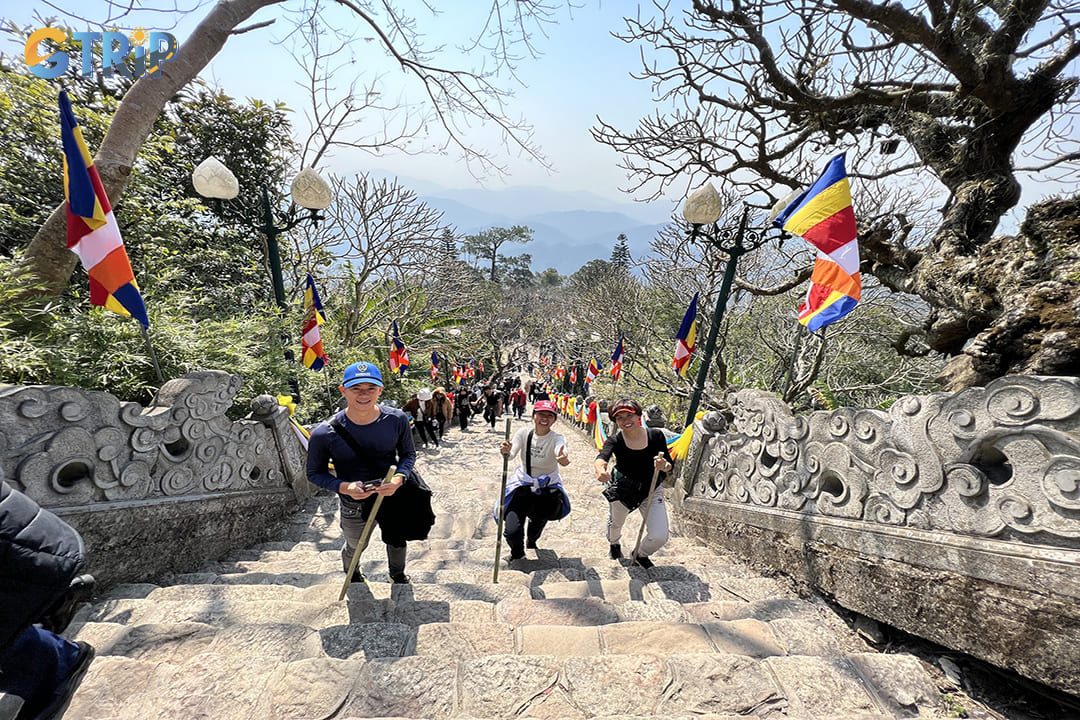
Wear and bring essential things for an enjoyable journey
Tips for visiting Yen Tu Mountain
There are a few key things to keep in mind to ensure a smooth and enjoyable experience:
- Respect the spiritual environment: Yen Tu is a sacred site with significant pagodas and temples. Dress modestly and respectfully, and consider bringing incense or offerings to honor local customs.
- Prepare for the hike: Wear sturdy hiking shoes, dress in layers for changing temperatures, and pack water and light snacks. If trekking to the summit, follow the marked trails for safety.
- Use cable car safely: If taking the cable car, follow staff instructions for a safe ride, and enjoy scenic views of the mountain.
- Respect local wildlife: Yen Tu is home to diverse flora and fauna. Avoid disturbing animals, don’t pick plants, and dispose of trash properly to help preserve the environment.
- Start early: Begin your journey in the morning to avoid crowds, especially during peak seasons, and to enjoy cooler temperatures on the mountain.
- Pack light, but smart: Bring essentials like sunscreen, a hat, and a small first-aid kit. Avoid overpacking, as the trek can be strenuous.
- Cash essentials: Carry some local currency, as card payments may not be accepted at small vendors, and you may want to buy offerings or snacks along the way.
- Stay hydrated and energized: Bring plenty of water and energy-boosting snacks. Staying hydrated is essential due to the elevation and physical exertion.
- Stay mindful of weather: Check the forecast beforehand, as conditions can change rapidly in mountainous areas. Pack a rain poncho or light jacket if rain is expected.
- Respect pilgrims and monks: Be mindful of visitors on spiritual journeys, especially during rituals or meditation practices, by keeping noise to a minimum.
Yen Tu Mountain is a famous spiritual destination in Quang Ninh for those who want to find a quiet location for a peaceful soul, explore and experience more about this mountain with the Quang Ninh tours of GTrip now.

